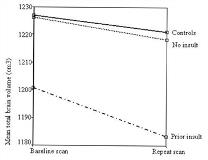CEREBRAL DAMAGE IN EPILEPSY: FINDINGS OF A LONGITUDINAL COMMUNITY-BASED QUANTITATIVE MRI STUDY
Abstract number :
C.06
Submission category :
Year :
2002
Submission ID :
3437
Source :
www.aesnet.org
Presentation date :
12/7/2002 12:00:00 AM
Published date :
Dec 1, 2002, 06:00 AM
Authors :
Rebecca S.N. Liu, Louis Lemieux, Gail S. Bell, Sanjay M. Sisodiya, Philippa A. Bartlett, Simon D. Shorvon, Josemir W.A.S. Sander, John S. Duncan. The Department of Clinical and Experimental Epilepsy, Institute of Neurology and MRI Unit, The National Socie
RATIONALE: Cerebral damage is a common finding in patients with epilepsy yet the timing and pathogenesis of these changes are poorly understood. We report on the first longitudinal population-based quantitative MRI study to investigate the effect of epilepsy on the hippocampus, cerebellum and neocortex over 3.5 years.
Objective: To determine whether recurrent seizures are associated with secondary cerebral damage and to identify clinical risk factors.
METHODS: 122 patients with chronic active epilepsy, 68 patients with new onset seizures, and 90 age and sex-matched controls were prospectively scanned 3.5 years apart on the same MRI scanner using identical acquisition sequences. Hippocampal, cerebellar and fully automated measures of total brain, grey matter, white matter and intracranial volume were performed on coregistered images and correlated with clinical risk factors. The investigator was blinded to scan order and all clinical information.
Difference images were obtained by subtracting the matched repeat image from the baseline image and filtered against a structured noise map. Focal necortical changes were quantified using a normalised regional brain atlas.
RESULTS: Baseline hippocampal and cerebral volumes were reduced in the epilepsy groups that had had antecedent neurological insults. Longitudinal volume losses were primarily determined by age and not seizure frequency. A history of a prior neurological insult was associated with a significantly increased rate of cerebral and cerebellar atrophy. Epilepsy duration, antiepileptic drug use, status epilepticus and gender were not associated with volume loss.
There were significant hippocampal volume losses in 1/90 controls, 2/68 newly diagnosed patients, and 6/122 patients with chronic epilepsy. No patients developed hippocampal sclerosis de novo.
After excluding changes due to artefact and confounding factors e.g. surgery, areas of neocortical loss developed in 21/82 controls, 17/43 newly diagnosed patients, and 50/96 patients with chronic epilepsy.
CONCLUSIONS: Hippocampal, cerebellar and global volume reduction is not an inevitable consequence of epilepsy, but the cumulative effect of an initial insult and ageing. Individuals with a history of prior neurological insults had increased susceptibility to cerebral damage.
Patients with chronic epilepsy were more likely to develop significant hippocampal and focal neocortical loss than controls and newly diagnosed patients. The patterns of loss were heterogenous and, in some individuals were remote from the putative epileptic focus.[figure1]
[Supported by: The Wellcome Trust and The National Society for Epilepsy]
